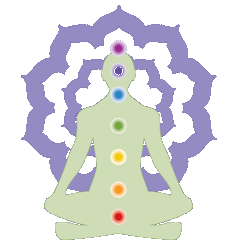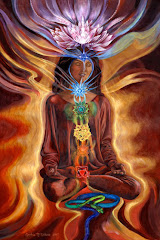Wednesday, May 28, 2008
Take the Poll!
If you glance to your left, you'll see a poll. Give me your input so I can create better and more enjoyable classes for you! ... Want something that's not on there? Have a request or question that requires more than clicking a little box or two? Please feel free to email me, or talk to me at the studio! Thanks, everyone. -Lindsay
Tuesday, May 27, 2008
Aaauuummmmm...

The sound of OM consists of more than just 'o' and 'm'. The Manddukaya Upanishad explains that OM consists of the universal vowel sounds A, U, and M, followed by the sound that is beyond verbal pronunciation - the pranic resonance that vibrates around the Heart.
The next time you chant OM, begin with your mouth open wider than normal. Leave the mouth and jaw open for a moment to really form the initial 'A'. Taking an inhale, fuel this sound with strong breath. Chant the 'A' first. Then, slowly begin to close the mouth and move the tongue forward, creating the 'OO' sound. Continuing to smoothly close the mouth, hum the 'M' with lips and teeth together. Keep the hum going until you run out of breath. Try this several times. Notice how we are inviting energy into the body (primarily through the breath) and then channelling it to a fine point - focused at your heart center behind anjalimudra. If we listen carefully, the OM can be heard resonating after the chant has stopped. This resonance is the life force that connects all things.
Sutra 1.28: When expressed with great devotion, the sacred sound reveals our divine nature.
The next time you chant OM, begin with your mouth open wider than normal. Leave the mouth and jaw open for a moment to really form the initial 'A'. Taking an inhale, fuel this sound with strong breath. Chant the 'A' first. Then, slowly begin to close the mouth and move the tongue forward, creating the 'OO' sound. Continuing to smoothly close the mouth, hum the 'M' with lips and teeth together. Keep the hum going until you run out of breath. Try this several times. Notice how we are inviting energy into the body (primarily through the breath) and then channelling it to a fine point - focused at your heart center behind anjalimudra. If we listen carefully, the OM can be heard resonating after the chant has stopped. This resonance is the life force that connects all things.
Sutra 1.28: When expressed with great devotion, the sacred sound reveals our divine nature.
Thursday, May 22, 2008
Sutra 1.1
As you may know, the Yoga Sutras have been translated many, many times by many different people. Some may find this confusing, but I think we can gain great wisdom in reading and comparing different translations; noticing the nuances of each word choice and the deeper understanding those nuances bring.
One of my favorite translations of the Sutras is by B.K.S. Iyengar, with its sharp and often succinct commentary, but recently I have been delving into a translation by Nischala Joy Devi, a work which views the sutras through the Heart. When reading the sutras, it's important to find a version that speaks to you. We are all on the same voyage, but we must journey in a way that works for us.
Sutra 1.1 is translated by Iyengar as "Now the practice of yoga." but by Devi as "With humility (an open heart and mind) we embrace the sacred study of yoga." It is not that one set of words is better than the other. The best set of words will be the one that opens your mind, creating true understanding of that which these words are trying to describe.
Here are two more of the opening Sutras, as translated by Nischala Joy Devi:
Sutra 1.2: Yoga is the uniting of consciousness in the heart.
Sutra 1.3: United in the heart, consciousness is steadied, then we abide in our true nature - joy.
So, regardless of whether you have actually practiced on a mat today, practice some yoga wherever you are. Pause for a moment. Become aware of the breath. Return to the present moment, and abide there in your true nature - joy. Of course, life will come barging back in again with problems and demands and emergencies. But once we have found our true nature, we can return there again and again, learning to hold a joyous and loving space in this big wide world.
One of my favorite translations of the Sutras is by B.K.S. Iyengar, with its sharp and often succinct commentary, but recently I have been delving into a translation by Nischala Joy Devi, a work which views the sutras through the Heart. When reading the sutras, it's important to find a version that speaks to you. We are all on the same voyage, but we must journey in a way that works for us.
Sutra 1.1 is translated by Iyengar as "Now the practice of yoga." but by Devi as "With humility (an open heart and mind) we embrace the sacred study of yoga." It is not that one set of words is better than the other. The best set of words will be the one that opens your mind, creating true understanding of that which these words are trying to describe.
Here are two more of the opening Sutras, as translated by Nischala Joy Devi:
Sutra 1.2: Yoga is the uniting of consciousness in the heart.
Sutra 1.3: United in the heart, consciousness is steadied, then we abide in our true nature - joy.
So, regardless of whether you have actually practiced on a mat today, practice some yoga wherever you are. Pause for a moment. Become aware of the breath. Return to the present moment, and abide there in your true nature - joy. Of course, life will come barging back in again with problems and demands and emergencies. But once we have found our true nature, we can return there again and again, learning to hold a joyous and loving space in this big wide world.
Wednesday, May 21, 2008
Dedicating your practice
We do yoga for all sorts of reasons. For stress relief, exercise, strength, a mood-lift, to help an injury recover, to get lost in a moving meditation... All of these reasons, physical, mental and spiritual, are good ones. The idea of dedicating our practice can take us one step further. When yoga is used to work on dissolving the Self, there is then tremendous energy available that can be turned outward for a genuinely positive effect on the universe.
Often, in our daily lives, we are directing energy outward already, but it is the energy of fear, anger, mistrust, or other negative states that our society unfortunately supports and engenders sometimes.
So first, we learn how to work with positive energy in our yoga practice; how to start it flowing in the body, and then how to radiate it outward.
We can dedicate this energy in a number of ways. Many of you already do so. Here are some of them:
Dedicate your practice to someone or something you are grateful for. A traditional meditation practice is to keep a running list of all people (& animals!) you feel gratitude for - and to extend this list by one every time you practice.
Dedicate your practice to someone in your life, who is struggling or suffering. Visualize your own efforts freeing up some energy for this person; gifting them some extra prana. In particular, you can offer challenges in your practice - and your willingness to face them - to this person, as an act of compassion and connection.
Dedicate your practice to your teachers, including not just your formal yoga teachers, but all the people and experiences in your life that "teach" you every day, by providing you with an opportunity to learn, change, reflect, grow, and practice.
Once we begin regularly dedicating our practice, it becomes an essential component of our yoga. From there, it is an increasingly easy transition to dedicate your time and attention positively during the rest of your day. You can meditate during time stuck in traffic, and send positive energy out to anyone you know who is feeling stuck or trapped in their life. You can bag your groceries at the grocery store and dedicate that energy to all the people who helped bring you that food - farmers, laborers, truckers - a string of countless interconnected people now involving you. You can listen with full attention to a child's description of all his favorite cartoons that you've never heard of, dedicating this compassionate attention to both the child and to yourself, for all the times you were not listened to by grown-ups. So this outward flow of energy does not come at your own expense! On the contrary, as you radiate this loving energy out to the world and everyone in it, you will begin to see and feel it everywhere. We are all Bodhisattvas walking this Earth, if we only stop and remember.
Often, in our daily lives, we are directing energy outward already, but it is the energy of fear, anger, mistrust, or other negative states that our society unfortunately supports and engenders sometimes.
So first, we learn how to work with positive energy in our yoga practice; how to start it flowing in the body, and then how to radiate it outward.
We can dedicate this energy in a number of ways. Many of you already do so. Here are some of them:
Dedicate your practice to someone or something you are grateful for. A traditional meditation practice is to keep a running list of all people (& animals!) you feel gratitude for - and to extend this list by one every time you practice.
Dedicate your practice to someone in your life, who is struggling or suffering. Visualize your own efforts freeing up some energy for this person; gifting them some extra prana. In particular, you can offer challenges in your practice - and your willingness to face them - to this person, as an act of compassion and connection.
Dedicate your practice to your teachers, including not just your formal yoga teachers, but all the people and experiences in your life that "teach" you every day, by providing you with an opportunity to learn, change, reflect, grow, and practice.
Once we begin regularly dedicating our practice, it becomes an essential component of our yoga. From there, it is an increasingly easy transition to dedicate your time and attention positively during the rest of your day. You can meditate during time stuck in traffic, and send positive energy out to anyone you know who is feeling stuck or trapped in their life. You can bag your groceries at the grocery store and dedicate that energy to all the people who helped bring you that food - farmers, laborers, truckers - a string of countless interconnected people now involving you. You can listen with full attention to a child's description of all his favorite cartoons that you've never heard of, dedicating this compassionate attention to both the child and to yourself, for all the times you were not listened to by grown-ups. So this outward flow of energy does not come at your own expense! On the contrary, as you radiate this loving energy out to the world and everyone in it, you will begin to see and feel it everywhere. We are all Bodhisattvas walking this Earth, if we only stop and remember.
Tuesday, May 20, 2008
Incorporating 'new' poses!
Hello, all! We are going to begin to focus more on the later poses in the Primary Series, which will specifically help develop greater hip and hamstring flexibility, as well as core strength. These are asanas such as Bhuja Pindasana, Kurmasana (tortoise pose), Kukkutasana (rooster pose), Upavistha Konasana (seated wide-angle stretch), Supta Padangustasana (reclining hand-to-big-toe pose), etc.
We have also started to incorporate some poses from the Second Series into some practices, and we will be doing more of this, for fun and variety.
If there are poses you would like to do in class, you are always welcome to make requests!
We have also started to incorporate some poses from the Second Series into some practices, and we will be doing more of this, for fun and variety.
If there are poses you would like to do in class, you are always welcome to make requests!
Monday, May 5, 2008
life continuum
Laughter is eternal, life is eternal, celebration continues. Actors change but the drama continues. Waves change but the ocean continues. You laugh, you change--and somebody else laughs--but laughter continues. You celebrate, somebody else celebrates, but celebration continues. -Osho
Subscribe to:
Posts (Atom)




